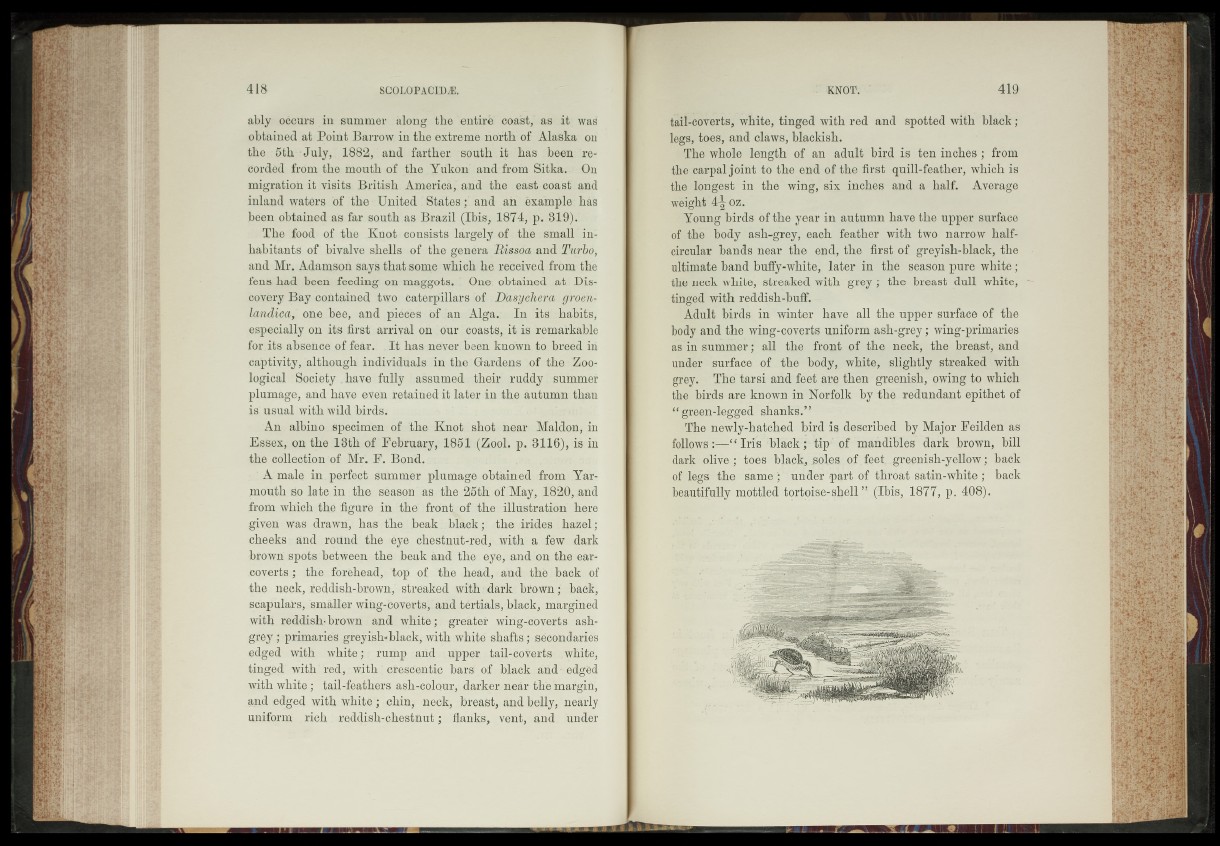
ably occurs in summer along the entire coast,' as it was'
obtained at Point Barrow, in the extreme north of Alaska: on
the 5th * July, 1882,' and farther, sputh it has been, recorded
from the mouth of the.Yukon and:from Sitka.-- On
migration it visits British America, and the east coast and
inland waters hf the s United 'States;Land an example; has
been obtained as far south as Brazil (Ibis, 1874, p. 31.9^:
The food o.f the .Knob consists largely of th e. small I inhabitants
of biye>l ve shells of the genera lli8SQa;&n&. ffurbd,
and Mr, Adamson saya.that some whichhe received from the
fens had been feeding on maggots, 1 One: obtained at. Discovery
Bay contained two. caterpillars '^$\I)eLsycher<&§rQm-:
landicaj one bee, and pieces of .an . Alga.: In its. • habits,
especially on its first, arrival on our 'coasts, it is remarkable
for,its absence of fear. , BChasmeVe^ePh known ta breed in
captivity, although' individuals in the .Gardens of th e '’Zoological
Society .have fully assumed, their' ruddy b summer
plutnjlge, and have even retained it later in the-: autumn .than
is usual ..with: jdidbirds;
An albino specimen (pjfethe -Knot. shot near Maldon, in
Esse?, on the ,13th qf'February, 185h:(Zd.oL p. 8116), is in
the cdllection of Mr. F'. Bond.\;
: : A male in. perfect summer plumage obtained, from .Yarmouth
So Jatei indwell season' as.-the IS ^ jan d
from which.the figure jLh the „frontoCihe..illustration here
given Was drawn, has:the, heak_black; the brides hazel;
cheeks and .round the eye chestnut-red;'- with a slew dark
brown spots, between, .their beak and the^ept|anden the ear-
.coverts; the forehead/‘top of 'the head, a’ndcdhel.back qf
the neck, feddis^h-rowm streaked withg darfe terpwn; back,
scap'ulars, smaller w in g b ^ a ^ i^ h d tertials, black, margined
with reddish? brown and white; Sp.iea.ter wmg^bqjl^tsj .ash-
grey f -primaries greyish'tbl-ac^with white ■shafts secondaries
edged with white;, rump ,--andj .upper tail-coveistsi ,whitfl
tinged' with’ red , : -Wjtb i crescen tic bars' of black .and'iodgid
with white; tail-feathers ash-colour, darker near- the margin,
and edged with white'; chin, npckg breast, and belly:, nearly
uniform . rich i reddish-chestnut; flanks, vent, and. undef
tsif-coverts, wMte, tinged with red and spotted with black;
legs, toes, and claws, blackish.
The whole length of an adult bird is ten inches; from
the carpal joint to' the end of the first quill-feather, which is
the longest in the wing, six inches and a half. Average
weight’4 i qz.
Young birds of the year in autumn have the upper surface
of-the body “ash-grey, each feather with two narrow half-
circular hands near the end, the first of greyish;black, the
ultimate band huffy-white, later in the season pure white;
the neck white, streaked with grey j the breast dull white, ■
tinged with reddish-buff, p
Adult birds in winter have^lhihe upper surface of the
body and the wiug-cpyprts uniform ash-grey; wing-primaries
as*in summer; all the front of the neck, the breast, and
under- surface o f. the body, white, slightly streaked with
grey.«* The' tarsi and feet are thenigrelm'lm owing to which
t.hfrhirds are known in Norfolk by th|Jredundant epithet of
* bgmen-teggedkh'anks. ’1
The newly-hatched ■ bird is described by Major Feilden as
follows IriVd51ack:*v‘tip/ of mandibles" dark brown, bill
dark olive ;' toes 'black, joles of feet, greenish-yellow; back
o'fljiegs- the same)' ufid'er^part of'bffroaf’, satin-white ; back
beautifully mottled tortoise-al^e^1 ..(Ibis, 1877, p. 408),s - t